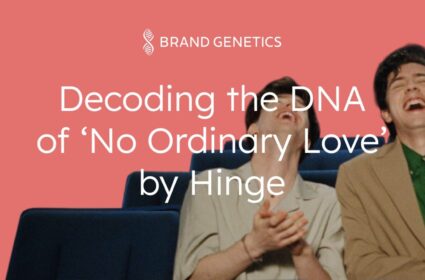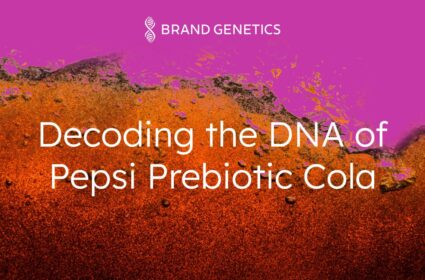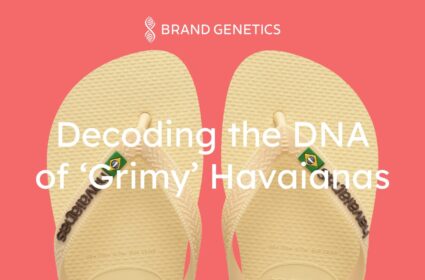Decoding the DNA of Starbucks Protein Coffee: How Code-Switching Brewed a Breakthrough
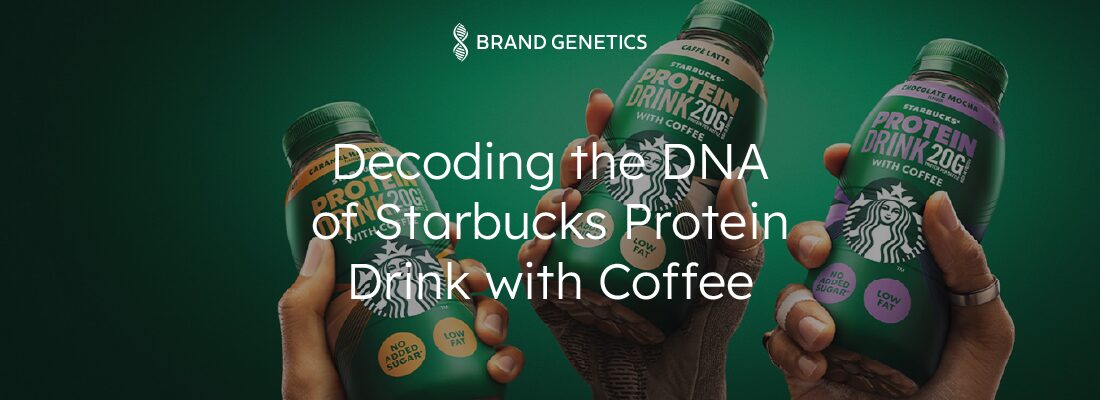
This article is part of our series on DNA of Campaigns. You can view the full series or download the report.
In a market crowded with functional drinks and frothy claims, Starbucks has managed to stand out. Their Protein Coffee RTD (Ready-to-Drink) is more than just a new SKU; it’s a case study in brand evolution, behavioural insight, and smart innovation.
Welcome to the first in our Decoding the DNA of… series – where we break down the behavioural science behind brands, innovations and campaigns that spark our curiosity.
One of our Associate Directors, Peter Sainthouse, had his interest piqued by Starbucks’ Protein Coffee because: “from a Brand Genetics’ perspective, I was intrigued by how well Starbucks brought their Seattle roots into a whole new category. I also drink it, and I like it. So, the question is: what can other brands learn from this?”
Cracking the Code-Switching
Launched in the UK in 2024, in collaboration with Arla, and expanded across EMEA in 2025, Starbucks’ Protein Coffee entered the growing RTD category as a beverage that blends Starbucks signature brew with 20g of protein, low-fat milk, and no added sugar. It comes in three flavours and caters to an audience seeking health benefits without sacrificing the ritual or caffeine rush.
What makes it work? Code-switching: the strategic choice where a brand adopts the visual language, tone, or conventions of another category – without losing its core identity – to connect with a new audience or enter a new space. Starbucks has borrowed design cues, functional expectations, and category norms from the protein drink space – and overlaid its brand equity right on top.
While other RTD coffees cling to slim cans and sleek, metallic bottles, Starbucks took a different route. The wide, squat bottle format is common in protein shakes, signalling “nutrition” rather than just “energy”, and the bold nutritional claims on front of pack are instantly recognisable category cues for health-conscious consumers.
This packaging instantly communicates the authenticity of a ‘protein drink’ to fitness-savvy shoppers, while still delivering the green siren promise of quality, tasty coffee. It’s a visual and functional hybrid – and it stands out on-shelf for that very reason.
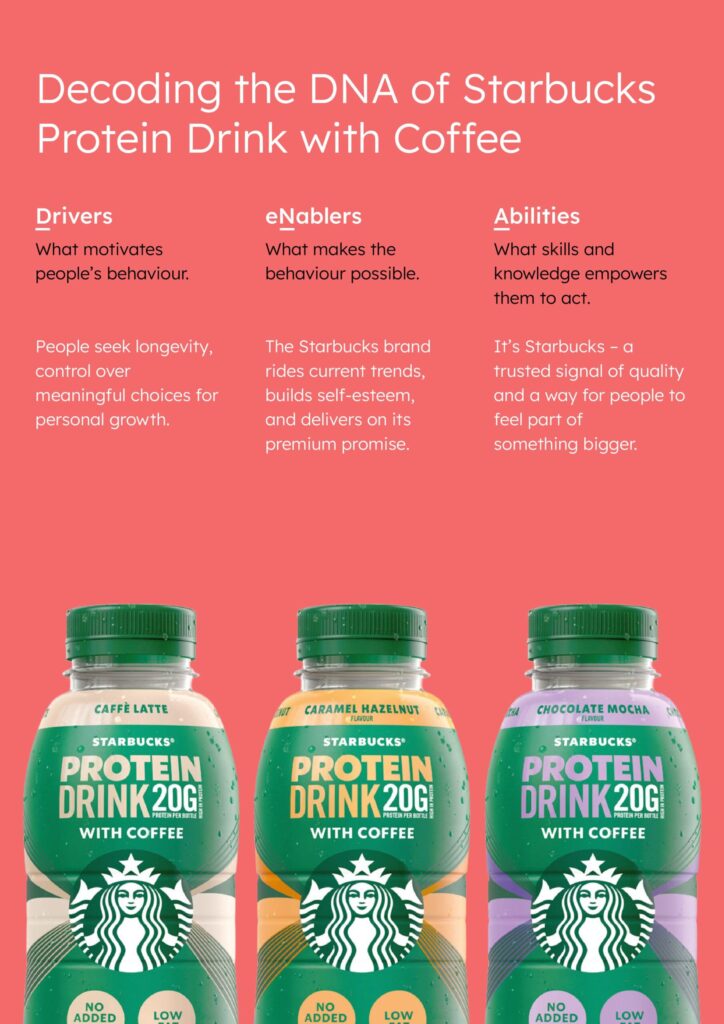
The DNA of Success: Drivers, eNablers, and Abilities
To understand the success behind Starbucks’ Protein Coffee, we leveraged our science backed, evidence-based model, uncovering its real DNA: Drivers, eNablers and Abilities. This approach goes beyond surface-level perceptions and reveals the deep behavioural architecture that can be tapped into by code switching.
-
Drivers: What’s motivating the behaviour?
Mastery: This product taps into the motivation of personal growth and competence. It allows people to feel they’re making informed, healthy choices – balancing indulgence and taste with intention.
Empowerment: With this product Starbucks conveys a sense of control, confidence and capability that makes it a powerful option for people seeking to enhance their wellbeing (or even sustain muscle strength for the growing number of protein-centric GLP-1 users).
Stronger, Longer: There’s also a future-focused health mindset at play. Consumers are looking for longevity, not just a quick boost. This product taps into the broader cultural shift towards sustainable wellbeing – not just beach-body fitness.
-
eNablers: What makes the behaviour possible
Esteem: It’s Starbucks. That alone confers a premium, aspirational signal. But add in the health benefits, and you get an extra layer of status – aligning with today’s values of self-care, achievement, and modern wellness.
Engagement: Taste matters. Texture matters. By offering a multi-faceted experience that stimulates the senses, encourages active participation in health trends, and provides variety and novelty, Starbucks keeps consumers interested and connected with the product.
-
Abilities: Skills and knowledge levels
Belonging: By tapping into the need for belonging, Starbucks connects people through shared values, health goals, and social identity, deepening loyalty and driving engagement. This drink gives consumers a way to feel part of something bigger – something no typical protein drink has offered. It also taps into trend participation, making the viral TikTok “Profee” movement (protein + coffee) easier, tastier, and more convenient.
Security: The association with Starbucks provides consumers with a sense of security in the product’s quality and safety. With regards to this new RTD, this is specifically beneficial as it provides the ability for cross-pollination between coffee and protein drinkers, effectively growing this nascent sub-category by doubling its potential audience.
Why It Works
At its core, Starbucks’ Protein Coffee acknowledges that consumers don’t live in single categories – they want holistic solutions. Coffee that fuels both body and confidence. A choice that’s both habitual and aspirational.
By understanding and responding to deeper motivations – not just trends – Starbucks has positioned itself as more than a coffee brand. It’s now a player in the functional wellness space with a product that feels fresh and delivers.
Key takeaways for brands
If you’re playing in the RTD space, there are plenty of learnings. Here are our top three:
- Code-switching done well: It’s a strategic move to signal relevance in a new space without losing brand equity – essentially speaking a new “category language” in a familiar, and powerful “brand voice.” It is NOT just coffee enhanced. It has a more authentic voice.
- Understand where you’re playing to spot the white space: by analysing the coffee RTD market first, and then both audiences of coffee and protein shake drinkers, Starbucks managed to spot the opportunity and bridge the gap. “We know Starbucks’ consumers are some of protein’s biggest fans” says Adam Hacking, Head of Beverages at Arla, “By appealing to existing protein drinkers as a trade-up opportunity and by tapping into the penetration opportunity for new shoppers, Starbucks Protein Drink with Coffee will continue to drive growth in the milk-based beverage category.”
- Design for identity and function: Starbucks tapped into motivations like mastery, esteem, and belonging to make the product feel like a smart, status-boosting choice for modern, health-conscious consumers.
In a market where shelf space is tight and attention spans tighter, Starbucks’ Protein Coffee is a rare blend of insight, innovation, and brand.


